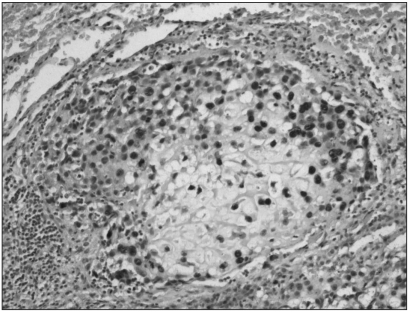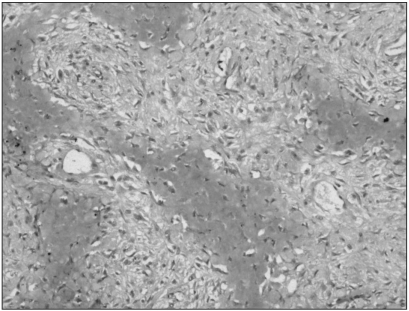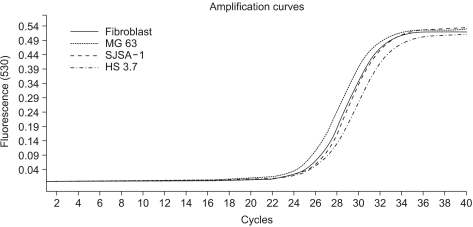Cancer Res Treat.
2005 Dec;37(6):360-364.
Overexpression of Metastatic Tumor Antigen in Osteosarcoma: Comparison between Conventional High-Grade and Central Low-Grade Osteosarcoma
- Affiliations
-
- 1Department of Pathology, College of Medicine, Hallym University, Anyang, Korea.
- 2MyGene Bioscience Institute, Seoul, Korea.
- 3Servizio di Anatomia Patologica, Istituto Ortopedico Rizzoli, Bologna, Italy.
- 4Department of Pathology, College of Medicine, Kyung Hee University, Seoul, Korea. ykpark@khmc.or.kr
Abstract
- PURPOSE
The metastatic tumor antigen (MTA) gene is a recently identified metastasis-associated gene which has implications in the signal transduction or regulation of gene expression. However, the expression of MTA in osteosarcoma and its potential relationship with metastasis have not been examined, forming the basis of this study. MATERIALS AND METHODS: We compared the expression levels of the MTA1 protein between 32 cases of high- grade osteosarcomas and 21 cases of low-grade osteosarcomas by immunohistochemistry. In addition, the mRNA expression levels of MTA1, 2, 3 in these osteosarcoma cell lines and control fibroblasts were evaluated by real-time quantitative PCR. RESULTS: MTA1 immunoreactivity was present in 81.25% of high-grade osteosarcoma specimens. Its expression was predominantly localized to the nucleus or cytoplasm of osteosarcoma cells. Thirteen (86.6%) of 15 patients who died of osteosarcomas displayed strong MTA1 expression. Both primary bone and pulmonary metastatic lesions exhibited MTA1 expression. All low- grade osteosarcomas were negative for MTA1 except for focal weak reactivity in two cases. The tested high-grade osteosarcoma cell lines showed marked amplification of MTA1 and MTA2 mRNA compared to control cells. CONCLUSION: These results suggest that MTA might be involved in the progression of high-grade osteosarcoma, particularly in hematogenous metastasis of osteosarcoma.
MeSH Terms
Figure
Reference
-
1. DeMarzo AM, Nelson WG, Isaacs WB, Epstein JI. Pathological and molecular aspects of prostate cancer. Lancet. 2003; 361:955–964. PMID: 12648986.
Article2. Dear TN, Ramshaw IA, Kefford RF. Differential expression of a novel gene, WDNM1, in nonmetastatic rat mammary adenocarcinoma cells. Cancer Res. 1988; 48:5203–5209. PMID: 3136918.3. Phillips SM, Bendall AJ, Ramshaw IA. Isolation of gene associated with high metastatic potential in rat mammary adenocarcinomas. J Natl Cancer Inst. 1990; 82:199–203. PMID: 2296049.
Article4. Sasaki H, Moriyama S, Nakashima Y, Kobayashi Y, Yukiue H, Kaji M, et al. Expression of the MTA1 mRNA in advanced lung cancer. Lung Cancer. 2002; 35:149–154. PMID: 11804687.
Article5. Toh Y, Oki E, Oda S, Tokunaga E, Ohna S, Maehara Y, et al. Overexpression of the MTA1 gene in gastrointestinal carcinomas: correlation with invasion and metastasis. Int J Cancer. 1997; 74:459–463. PMID: 9291440.6. Iguchi H, Imura G, Toh Y, Ogata Y. Expression of MTA1, a metastasis-associated gene with histone deacetylase activity in pancreatic cancer. Int J Oncol. 2000; 16:1211–1214. PMID: 10811997.
Article7. Toh Y, Pencil SD, Nicolson GL. A novel candidate metastasis-associated gene, mta1, differentially expressed in highly metastatic mammary adenocarcinoma cell lines. J Biol Chem. 1994; 269:22958–22963. PMID: 8083195.8. Xue Y, Wong J, Moreno GT, Young MK, Cote J, Wang W. NURD, a novel complex with both ATP-dependent chromatin-remodeling and histone deacetylase activities. Mol Cell. 1998; 2:851–861. PMID: 9885572.
Article9. Mahoney MG, Simpson A, Jost M, Noe M, Kari C, Pepe D, et al. Metastasis-associated protein (MTA) 1 enhances migration, invasion, and anchorage-independent survival of immortalized human keratinocytes. Oncogene. 2002; 21:2161–2170. PMID: 11948399.10. Moon WS, Chang K, Tarnawski AS. Overexpression of metastatic tumor antigen 1 in hepatocellular carcinoma: Relationship to vascular invasion and estrogen receptor-α. Hum Pathol. 2004; 35:424–429. PMID: 15116322.
Article11. Sasaki H, Yukiue H, Kobayashi Y, Nakashima Y, Kaji M, Fukai I, et al. Expression of the MTA1 mRNA in thymoma patients. Cancer Lett. 2001; 174:159–163. PMID: 11689291.
Article12. Hofer MD, Kuefer R, Varambally S, Li H, Ma J, Shapiro GI, et al. The role of metastasis-associated protein 1 in prostate cancer progression. Cancer Res. 2004; 64:825–829. PMID: 14871807.
Article13. Toh Y, Kuninaka S, Endo K, Oshiro T, Ikeda Y, Nakashima H, et al. Molecular analysis of a candidate metastasis-associated gene, MTA1: possible interaction with histone deacetylase 1. J Exp Clin Cancer Res. 2000; 19:105–111. PMID: 10840944.14. Toh Y, Ohga T, Endo K, Adachi E, Kusumoto H, Haraguchi M, et al. Expression of the metastasis-associated MTA1 protein and its relationship to deacetylation of the histone H4 in esophageal squamous cell carcinomas. Int J Cancer. 2004; 110:362–367. PMID: 15095300.
Article15. Nicolson G, Nawa A, Toh Y, Taniguchi S, Nishimori K, Moustafa A. Tumor metastasis-associated human MTA1 gene and its MTA1 protein product: role in epithelial cancer cell invasion, proliferation and nuclear regulation. Clin Exp Metastasis. 2003; 20:19–24. PMID: 12650603.
- Full Text Links
- Actions
-
Cited
- CITED
-
- Close
- Share
- Similar articles
-
- Low-grade Osteosarcoma of the Spine: A Case Report
- Differential Expression of CXCR4 in Conventional High-grade and Low-grade Central Osteosarcoma and Its Prognostic Implications
- Osteosarcoma arising on the surface of long bones: a review of radiologic and histologic spectrum in 9 cases
- Expression of Carbonic Anhydrase IX Correlates with Histologic Grade and Metastasis in Osteosarcoma
- A Case of Osteosarcoma in Maxilla





